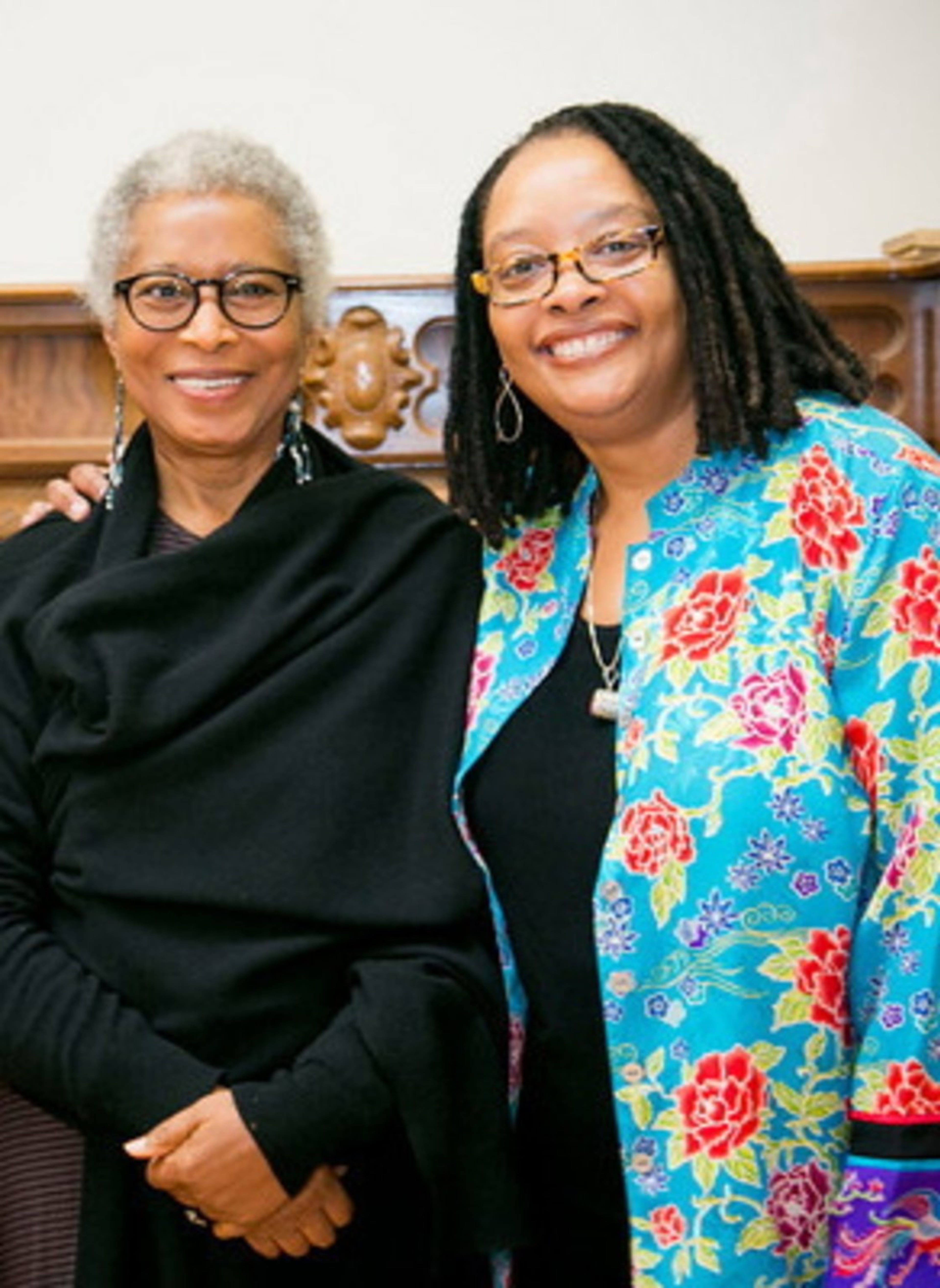‘Gathering Blossoms Under Fire’ an intimate account of Alice Walker’s creative life

How to enjoy the world and smell the roses while artillery shells burst all around? There’s guidance for that in “Gathering Blossoms Under Fire,” a 500-page digest of novelist Alice Walker’s edited journals, set to be published April 12.
Enjoy she does.
Confiding almost daily to her spiral-bound and leather-bound audience, Walker offers accounts of the earthy pleasures of food and companionship, sex and gardening, and a career that suddenly rockets into the stratosphere with the publication of “The Color Purple.”
The pleasures, and financial rewards, come amid a hail of bullets. Walker is assailed by racist whites, outraged that she married a white man, and by African Americans, angered that her Pulitzer Prize-winning novel dwells on the violence of Black men.
There is also deep sadness along the way: She reels from the death of her mother, and today she’s still recovering from a surprise loss that takes place after the book ends.
“Blossoms” was edited by author, college professor and former Atlanta Journal-Constitution editor Valerie Boyd, whose 2004 biography of Zora Neal Hurston, “Wrapped in Rainbows,” earned Walker’s admiration and trust.
They worked together for years. Then two months before Walker’s journals were set to be published, Boyd died of pancreatic cancer, a disease she had been quietly fighting since 2018.
“Working with Valerie was one of the greatest adventures of my life,” said Walker, 78, in a Zoom call from her country home in Northern California’s Mendocino County, a rolling valley compound with vegetable and flower gardens where she plants peonies, squash, onions and beans.

“When she died I suffered,” said Walker. “I felt her death, in a way, more sharply than I felt some deaths in my own family, because we had grown very close, and I trusted her completely with my journal, with my thoughts. With my sentences.”
The journals begin in 1965, when Walker is a 21-year-old student at Sarah Lawrence, an exclusive all-woman’s college in New York that went co-ed in 1968.
They follow her marriage to Mel Leventhal, a civil rights lawyer; their move to Mississippi; marching with MLK; the birth of a daughter; subsequent divorce; her tenure at Ms. Magazine; her essays, short stories, poems, novels and the rise of her starry literary career.
They continue through 2000, as Walker confesses “I’m 55. I don’t mind looking my age — it looks just fine, as far as I’m concerned.”
In an afterword, a 77-year-old Walker promises a Volume II. But that was written before Boyd’s death. During her Zoom call, she’s not so sure, because “Valerie is not here. I don’t know if there will ever be another Valerie, to equal her integrity, calm and grace.”
Walker’s journals, 65 notebooks filled with her tidy, compact, half-script, half-print, went to Emory University’s Rose Library in 2007, embargoed from the eyes of scholars and fans until 2040.
But Walker decided to publish part of that bounty, and Boyd was charged with selecting passages from those journals for “Gathering Blossoms.”
While there were some excisions to protect the privacy of her friends, Walker said the goal was not prudence but brevity: Nobody, she said, wants to read 1,000 pages of a journal.
As far as prudence is concerned, she doesn’t shy from commenting on the shortcomings of her friends and lovers. “Today all I thought about was how bored I am in this marriage,” she writes, in an undated entry from the mid-1970s, of her marriage to Leventhal.
Later, after her marriage is over and a romance blooms with author Robert Allen, she also gives him a hard time. “Robert,” she writes on March 15, 1984. “I still don’t trust him. Often don’t even like him.”
Her colleagues are also prey to her acid pen. In an entry from May 1979, when the paperback rights to Toni Morrison’s novel “Song of Solomon” sell for $300,000, Walker examines her own jealousy and decides that Morrison deserves the good fortune, “even if I feel her characters never go anywhere.”
Was she worried that she might hurt some feelings among friends and fellow authors when the journals were published? “They might be very upset. Who knows? I’m writing about my life, and they were a part of it. We’ve been through many struggles together, and I love them all.

“I feel thankful and content with what I am. People might have difficulty if they expect something else than what I am. The world is large.”
Walker is also frank about her bisexuality, her love affair with pop singer Tracy Chapman (about which she’s been circumspect in the past) and an unconsummated mutual infatuation with music producer Quincy Jones.
There is entertainment value in her tour through Hollywood. There is also magic in watching her fiction, short stories, poems and essays come into being. Often that happens offstage. Sometimes right in front of us.
In a July 27, 1977, entry we see her sketch the beginning of “The Color Purple,” with characters based on her grandparents. In an undated page from 1980, we see a transcribed conversation with her daughter Rebecca, that begins:
“Mama, why are you so sad?”
“Because I can’t write the book I need to write.”
“Why can’t you write the book you need to write?”
“Because it would be painful.”
Later, as she is fashioning a screenplay for “The Color Purple,” she offers a thumbnail sketch of each character to help Steven Spielberg with his movie adaptation..
“I had forgotten that was in there,” said Walker over Zoom, dressed in casual clothes, her graying hair wrapped in a kerchief. “Forty years later — 40 years! — there I was flipping through the book.”
Keeping a journal since her teen years has helped her as a person, as much as a writer, she said.
“I think the reason you keep a journal is to find out who you are, as you unfold,” she said. “Often, if you don’t make some kind of record, you forget: You crossed that river, climbed that mountain, fell down that hill. I do it partly because I don’t have a great memory for day-to-day things.”
Some of the day-to-day things are fascinating.
Early on she offers an accounting of the meager proceeds from her first novel, 1970′s “The Third Life of Grange Copeland,” which she says she sold on the street.
In an entry from Nov. 22, 1978, she writes “Grange has sold 845 copies in paper. This nets me $42. I can’t believe it. Hardcover sales: 77. Nets me $61.22. Definitely better to have hardcover sales.”
“It was a teaching,” she says now. Her efforts to make a living, to save, to buy a house, are reflected in columns of figures and goals. In an undated 1977 entry, she totals her earnings from Ms. Magazine, lectures, teaching a course at Yale, and concludes: “I probably earn about $20,000 a year, and that’s a lot. My goal, by Dec. ‘78, is to have saved $30,000 to pay down on a house!”
Speaking from her California home, she says, “I want young people who may or may not read this to know that you have to be very practical. You need a place to live, where you’re not necessarily afraid to walk on your own block, your own lane.”

When Walker visited Agnes Scott in 2018, she told the audience that reading over the journals reminded her: “I hate debt.”
Debt, she said, has forced many artists to do things they hate, and then to drink themselves into the twilight zone to feel better.
She wants her readers to avoid those pitfalls. “You need to figure out how to support yourself,” she said over Zoom. “I’m offering this blow by blow in the early days, especially on what that feels like, to go out in the world, leaving a comfortable marriage where I didn’t have to worry about stuff. Making my own way, figuring out how to do that. We had 11 rooms. I moved into two tiny ones. I worked these jobs that paid very little.”
Walker includes an afterword in the book, musing about whether her political activism has accomplished much. She also put back in some entries that had soothing words about friends she may have criticized. “After being hard on Robert a lot, I wanted to end with the times we were so close,” she said. (“With Robert,” reads one entry in the afterword, “I feel at rest, as if my spirit, not just my mind or body, has found rest.”)
And on the topic of political activism, Walker said the current era, with its banned books and efforts to reduce discussions of race in the classroom, does not worry her.
“I can’t let it discourage me too much, because what we want in people is the thirst to know the most they can learn, about how rabidly many people are trying to push us back.”
Activists need a certain “muscle” to get to the truth, she said, the kind of muscle you develop by confronting resistance. So such resistance is useful.
“It’s hard to make me feel daunted.”
VIRTUAL BOOKSIGNING
Alice Walker will conduct two virtual events this month. At 7 p.m. Tuesday, April 12, the Georgia Writers Museum will conduct a “meet the author” event online. Go to georgiawritersmuseum.org to register.
At 7:30 p.m. Wednesday, April 13, Charis Books & More will present Alice Walker in conversation with Atlanta author Pearl Cleage. The event is co-hosted by the Auburn Avenue Research Library on African American Culture and History. The event will take place on crowdcast, Charis’ virtual events platform. Register at www.crowdcast.io/e/gathering-blossoms-under/register


